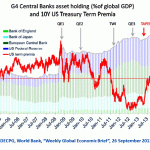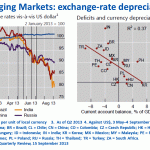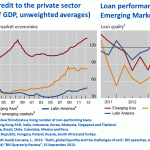Otaviano Canuto
The mid-year season was marked by a strong pressure of capital outflows and exchange rate devaluations in several systemically relevant emerging market economies. Announcements in May that the Federal Reserve had started to focus on phasing out its asset-purchase program – otherwise known as quantitative easing or (QE) sparked a surge in bond yields that in turn triggered an asset sell-off in those emerging markets. Although subsiding in September, particularly after the Fed announced that “tapering” would not begin yet, concerns remain about what will happen when the actual unwinding of QE eventually unfolds. We argue here that events since May could ideally provide a “fire drill” that might induce emerging markets to address various policy shortcomings that have been exacerbated by the flood of global liquidity in the last few years.
Quantitative Easing has been Counter-cyclical in Advanced Economies…
After lowering policy interest rates to near zero, the central banks of the major economies started in 2009 an expansion of their balance sheets. The steady purchase of government bonds and other assets by G4 central banks have pushed their combined asset holdings to around 15% of global GDP, up from roughly 8% in 2008 (Chart 1).
The initial rounds of central bank asset purchases were aimed at avoiding a deepening of on-going asset liquidation processes. These were caused by private agents trying to deleverage en masse after the Post-Lehman financial quasi-collapse or, in the case of the euro area, when the crisis of confidence on the euro convertibility unfolded. Without such backstop, more intense asset deflation processes could have been accompanied by widespread bankruptcies and further GDP losses (Brahmbhatt et al, 2010).
In the case of the US Fed, subsequent rounds of asset purchases, besides propping up mortgages through the acquisition of mortgage-backed securities (MBS), were aimed at lowering long-term yields. This can be seen in the evolution of the ten-year US Treasury term premium –accounting for real and inflation risk premiums – toward negative levels also depicted in Chart 1.
“Most emerging markets are currently not as vulnerable as they were in previous episodes of global interest rate hikes.”
Even during its more aggressive stage, the Fed’s QE is perhaps best seen as an accommodative, counter-cyclical policy. Chart 2shows how the money multiplier practically “fell off a cliff” on both US and European sides of the Atlantic after the crisis struck. This reflected private agents’ preference for holding very high levels of excess reserves of liquidity rather than creating broad money through credit expansion.
Unconventional monetary policies – QE combined with “forward guidance”, i.e. signaling of central banks’ future policies – prevented the unraveling of the financial system and of private asset-liability structures, and countervailed an aggregate demand slump in affected countries. Such policies have thus helped smooth the private sector deleveraging process and, in the case of the Euro, helped save the currency by reducing perceived risks of convertibility. The countercyclical effect could arguably have been stronger if accompanied by countercyclical fiscal policies in the US. On the euro area side, the ECB action would also arguably have been more effective if followed by less austerity and/or structural reforms in crisis-ridden countries, faster euro-wide institutional development and a more proactive writing-off of impaired assets (given the costs of “procrastination” – Canuto, 2013a). Notwithstanding such concerns, and with the benefit of hindsight, one can still assert that such unconventional monetary policies helped avert a graver macroeconomic disaster.
On the other hand, one may point out several factors tending to decrease the effectiveness and increase the risks of QE policies going forward (Caruana, 2013). Prolonging the period with central bank support to risk-taking not only creates hazards by itself, it also raises the temptation to “evergreen” impaired liabilities with the hope of postponing – perhaps forever – the acknowledgment of losses. Furthermore, future normalization of central bank balance sheets becomes even more challenging. It is no surprise then that, last May, rising confidence on the durability of the US economic recovery yielded growing Fed references to a “tapering” – shrinkage at the margin of asset purchases – probably later in the year.
… And Procyclical for Emerging Market Economies
At the outset of the period of unconventional monetary policies in advanced economies, one could anticipate a massive capital reallocation and associated changes in leverage capacity moving from advanced to emerging market economies. Gloomy prospects for advanced economies and the euro area crisis, combined with diverse channels of transmission for QE, would probably pave the way for portfolio shifts to emerging markets, helped by their post-2008 resilience. Indeed, prices of emerging market assets (including financial assets and real estate) were already reflecting such a relative change of fundamentals between the two groups of economies. Some analysts pointed out a major potential of risks for emerging markets in case excessive euphoria prevailed and finance-led asset bubbles were allowed to rise (Canuto, 2011).
In retrospect, it is evident that the world experienced a significant increase in assets and exposure to emerging markets in 2009-12, despite efforts by these economies to introduce capital controls and other macro-prudential measures (Canuto and Cavallari, 2013). Outstanding emerging corporate bonds grew fast throughout the period. “Dedicated” emerging market equity and bond funds were bloated and followed by the much larger “crossover segment” (retail, hedge funds, and institutional). To different country-specific extents, this wave of global liquidity helped fuel credit booms, asset price inflation and macroeconomic over-heating in emerging market economies (Caruana, 2013).
In the case of equities, as illustrated in Chart 3, the tide started to turn last year when news on a growth slowdown in major emerging markets predominated (on China and Brazil, see Canuto, 2013b). But it was only last May that significant global portfolio rebalancing was put in motion, when upbeat news on US employment released on May 3th firmed the positive outlook for its economy, followed by an uptick on long-term yields. On May 22th a Fed talk about shrinking – and eventually reversing – its asset purchase program was made public – see Charts 3 and 4. While unconventional monetary policies have been countercyclical in advanced economies implementing them, they have had pro-cyclical consequences on emerging markets — boosting credit and demand when most economies among the latter were already heated up, and threatening to accentuate a slowdown where it started to happen.
The global portfolio adjustment has seen a movement away from countries/markets deemed as vulnerable to QE unwinding and toward those whose prospects appear likely to improve as a consequence of possible future policy change. Chart 5 shows how, prior to the September calm-down, exit flows and exchange-rate devaluations were not distributed evenly among emerging market economies, but rather concentrated on large countries exhibiting current-account deficits (Brazil, India, South Africa, Indonesia, and Turkey). However, even China felt ripple effects through a severe liquidity squeeze in its interbank market in June, partially reflecting an accentuated slowdown in US dollar inflows in late May [see BIS (2013) on this and domestic factors behind the brief but acute episode of interbank volatility in China.]
The Recent Emerging Market Sell-Off May Have Turned Out to be a Timely Wake-up Call for the Post-QE World
The effects of an announced “tapering” — reduction at the margin — of monthly asset purchases in the near future by the Fed was felt immediately, even though its start date was yet to be established. A frequent question now asked is whether U.S. long-term Treasury yields will skyrocket when the Fed actually begins to shrink its balance sheet toward more “normal” levels, and if they do, could the resulting upheaval make the recent emerging market turmoil look like a walk in the park.
Two factors may mitigate the scenario of skyrocketing long-term interest rates. First, if we are right in our description above, the Fed’s balance sheet expansion has not been much greater than the world’s demand for liquidity in dollars. There is ground to believe that the Fed mostly accommodated the private (bank and non-bank) demand for “excess reserves”, nudging down the nominal term premium later in the process. Provided that the US economic recovery settles in and the private demand for long-term bonds – and other assets, like MBS — normalizes, the Fed will not have to dump unwanted assets on the market and, thus, be obliged to offer huge discounts and high interest rates. There is no reason for the Fed to risk derailing the economic recovery by not following such a path and the decision not to start tapering in September yet confirms its propensity to move cautiously and gradually.
This leads us to the second reason for not expecting interest rates to go through the roof. There is no sign of an uptick on U.S. inflation rates or expectations and, therefore, no need for substantial interest rate hikes in the foreseeable future. Interest-rate policies could conceivably be separated from the unwinding of the balance-sheet expansion, but the fact is that the U.S. economy is likely to remain on a low-inflation environment for some time.
Most emerging markets are currently not as vulnerable as they were in previous episodes of global interest rate hikes. Current exchange rate devaluations reflect the adjustment flexibility embedded in their currency regimes, as opposed to pegged rates which in the past made emerging market currencies sitting-ducks for speculative attacks. Furthermore, reserve cushions are much larger, both corporate and public-sector debt positions in most EMs are not as fragile as they were on the brink of the 1990s crises, and the proportion of equity-like investment and domestic currency-denominated debt is higher. The recent credit boom in some countries has left a vulnerable legacy, especially in Asia – Chart 6 – but likely a more manageable one, at least as compared to previous experiences. The debt legacy from China’s credit-based real estate boom in the last few years can ultimately be addressed with substantial official reserves and the available fiscal space.
Not by chance, the policy space available in emerging market economies most affected by the recent sell-off has already been put into action to avoid the emergence of vicious circles that spirals of capital outflows and exchange rate depreciations might have caused. Such policy reactions have been as important to the September calm as the signs of caution in the QE taper coming from the Fed.
Provided that we are right regarding caution and gradualism in the exit from central banks’ massive asset purchase programs, as well as on the scope for emerging market policy reaction, the global portfolio adjustment launched in May can be seen as offering an orderly fire-drill for the real unwinding of QE. At the very least, those emerging market countries most likely to be affected have greater recognition of their vulnerability from splurging in the global liquidity pool and leaving their fiscal and/or current-account deficits unaddressed.
Regardless of the role played by the liquidity wave flooding into emerging market economies, these countries have in general been too complacent over the need for structural reforms in order to explore new growth opportunities (Canuto, 2011). We noted above how procrastination in adjusting and restructuring portfolios is a potential downside of QE. To some extent, the aggravation of fiscal and balance-of-payments fragilities in some liquidity-receiving emerging markets, facilitated as an unintended consequence of QE, has exactly been an example of such an accommodation. From this perspective, unwinding QE policies may ultimately be good news for emerging markets, especially if the withdrawal of global liquidity is followed by a sharper focus on promoting country-specific reform and restructuring.
First appeared at Capital Finance International, autumn 2013






